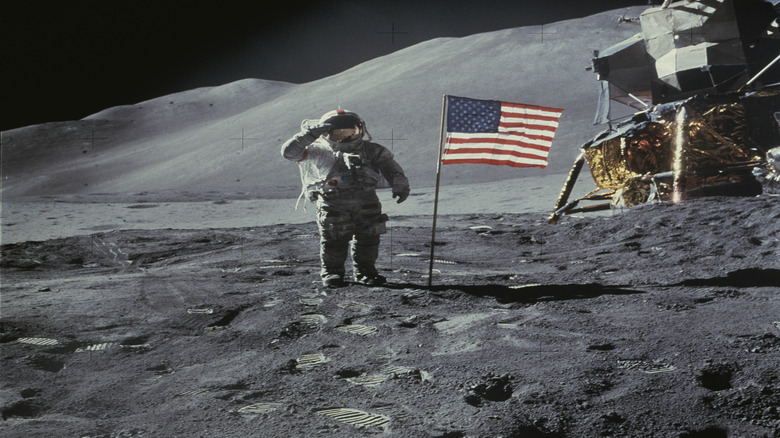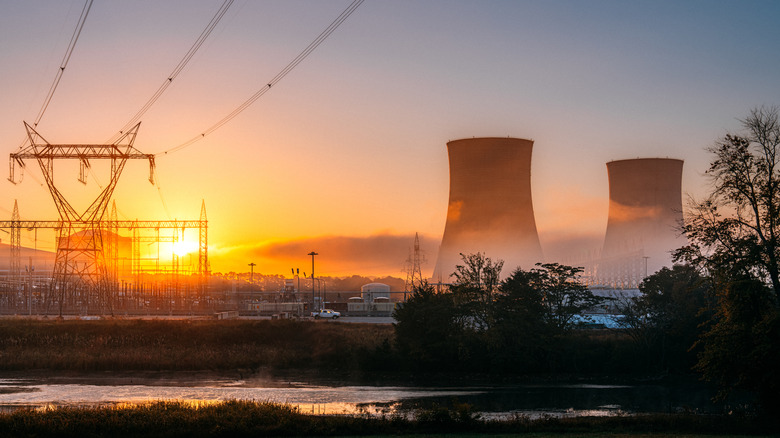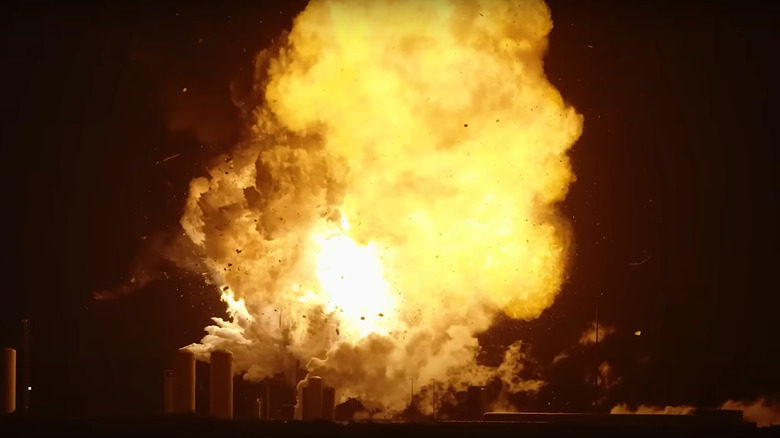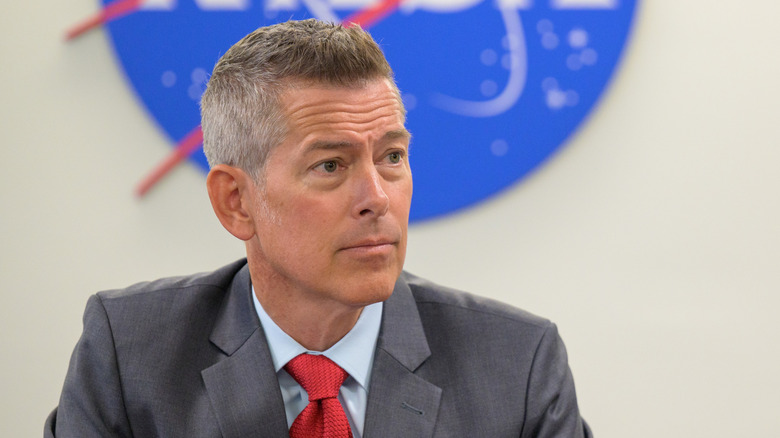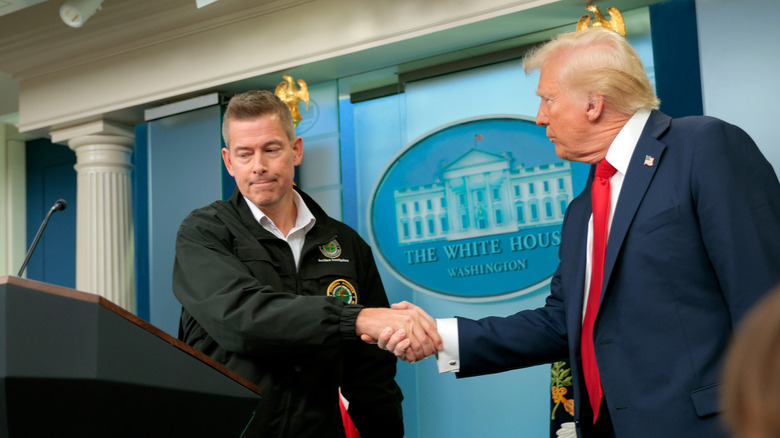Is NASA Building A Nuclear Reactor On The Moon? Here's What We Know
NASA is bringing nuclear energy to the moon. According to internal agency documents obtained by Politico in August 2025, Interim NASA Administrator Sean Duffy looks to place a 100-kilowatt nuclear generator on the moon by 2030. The plan comes after China and Russia announced a joint venture to launch a lunar nuclear power plant by 2035, and is seen by many as the next domino in an escalating space race between the world's premier powers.
Sending a nuclear reactor into space is nothing new. The practice dates back to the Cold War, when the U.S. launched the first nuclear reactor into space in 1965. Since then, Russian and American scientists have used thermoelectric generators extensively, powering select satellites, the Mars Rover, and the Voyager probes. Nuclear energy presents several advantages over the solar panels used by most low Earth orbit satellites, particularly in areas like the moon where sunlight is inconsistent.The Trump administration has had its eyes on a lunar reactor since its first term, although its progress then was minimal. In 2021, under the Biden administration, NASA announced it would launch a lunar reactor "within a decade," only to revise the claim to the mid-2030s by 2024.
Mass budget cuts, labor shortages, and an influx of high-profile projects like the Artemis 3 lunar landing will likely make it difficult for NASA to meet the President's audacious timeline. And while a longer project timeline may ease these difficulties, time is the defining factor for this administration, as the U.S. seeks to beat its Eastern rivals to the moon once again. As an anonymous senior NASA official told Politico, "It is about winning the second space race."
Going nuclear
Scientists believe that nuclear energy is critical to America's lunar ambitions. While solar is sufficient in powering low Earth orbit operations, the moon's slow rotation speed causes its surface to experience fourteen consecutive days of darkness at a time. This scarcity of sunlight renders solar power inefficient, with most lunar rovers lacking the energy stores to make it through a single lunar night. Nuclear reactors present an intriguing alternative. Although the 100-kilowatt reactor is smaller than most commercial nuclear plants, experts predict that it may generate the equivalent of 70 to 80 homes, powering several lunar operations, including enclosed habitats, research outposts, lunar rovers, 3D printers, and life support systems.
According to Dr. Bhavya Lal, a former associate administrator at NASA, the reactor, like America's 94 commercial reactors, will convert the heat of a controlled reaction of uranium fuel into energy. However, the Moon's lack of an atmosphere or water supplies complicates this process, as plants use vast stores of water to cool reactors while expelling excess heat into the atmosphere. NASA will need to build massive radiators to offload this extra heat.
Harsh environmental factors make a lunar reactor much more complicated. Its lack of an atmosphere means that components must operate in a vacuum. Extreme temperatures are also a concern, as the moon's surface temperature ranges between 250 and -400 degrees Fahrenheit. Moonquakes and meteorite strikes, meanwhile, could threaten the reactor's structural integrity.
Getting off the ground
To get a reactor to the moon, NASA will likely have to depend on SpaceX's Starship program, which the Elon Musk-led company touts as the world's most powerful rocket system. However, depending on SpaceX to execute this mission is no longer a given, as the Starship rocket kicked off 2025 with four straight explosions and counting. Whether SpaceX can meet the agency's short deadline is a major concern in light of these uncharacteristic setbacks. Already, the company is struggling to meet NASA's 2027 Artemis 3 lunar mission deadline — a project NASA paid SpaceX $4 billion to complete.
These recent setbacks are an optics nightmare for a nuclear program. Sean Duffy, who also serves as the Secretary of Transportation, stresses that the rocket won't be carrying a live reactor, while industry professionals echoed that it likely wouldn't activate until a safe orbiting distance 621 miles above Earth's surface.
Katheryn Huff, a professor of nuclear engineering at the University of Illinois at Urbana-Champaign who served as the Biden Administration's assistant secretary for nuclear energy at the Department of Energy, posited that the greater concern may be disposing of the reactor after its lifespan. Reentry into the Earth's atmosphere has proven a difficult for nuclear programs. One example Huff highlights is the 1978 Kosmos 954 disaster, in which a Russian nuclear-powered satellite exploded upon reentry and scattered nuclear debris across Canada.
If you're not first, you're last
Several legal structures will govern this next stage of space exploration and resource management. On the most basic level, a lunar reactor is legal under the U.N.'s 1992 Principles Relevant to the Use of Nuclear Power Sources in Space, which allows nuclear power when other sources prove inefficient. But experts believe the rationale behind the U.S.'s furious lunar push is rooted in a different U.N. edict: the 1967 Outer Space Treaty prohibiting territorial claims on the moon.
While the treaty bans settlements, Article IX requires that countries respect each other's infrastructure, stating that each must act with "due regard to corresponding interests of all other State Parties." According to Michelle L.D. Hanlon, a professor of air and space law at the University of Mississippi, the stipulation "means if one country places a nuclear reactor on the Moon, others must navigate around it, legally and physically. In effect, it draws a line on the lunar map." In this way, space infrastructure becomes a quasi-workaround for countries looking to control lunar sites.
While there's been talk about melting roads onto the moon to facilitate easier travel, Hanlon predicts that countries will likely race to establish infrastructure in resource-rich regions like the lunar south pole to cement and prohibit access. Duffy confirmed this rationale during a U.S. Department of Transportation press conference, that NASA's push is all about getting there first. "There's a certain part of the moon that everyone knows is the best," he said, "We have ice there. We have sunlight there. We want to get there first and claim that for America."
The next space race
Duffy's directive has one rival nation in mind: China. As the administrator stated in an August press conference, the U.S. is "in a race with China to the moon. And to have a base on the moon, we need energy." As it stands, NASA's 2030 timeline corresponds with China's plans to land its first astronauts on the moon that same year.
In April 2025, Beijing announced it would build a lunar nuclear plant by 2035. The project, first announced by Russia in 2024, would power the International Lunar Research Station (ILRS) – a partnership between the two powers and 15 additional nation-states and international organizations. Beijing's announcement comes as its lunar program approaches several key milestones, including the 2028 Chang'e-8 mission to test technologies for lunar base construction. Russia, for its part, looks to play a large role in this next era of space exploration. In particular, Chinese officials have touted its nuclear space pact with Russia as a distinct advantage, with Wu Weiren, chief designer of China's lunar program, saying Russia "leads the world" in nuclear space reactors, proclaiming "it is ahead of the United States."
Some see lunar infrastructure as an opportunity for cooperation, rather than exclusion. So far, however, the U.S. hasn't announced if it will partner with any nation-states in its reactor project. Rather, the agency seems to be broadly leaning towards commercial partnerships, with its premier collaborative space effort, the International Space Station, set to be replaced by commercial stations in 2030. Taking Duffy's directive at face value, NASA's primary concern may be preserving its spot at the table rather than inviting others to join it, as it stresses the need for NASA to build its reactor before a rival can "declare a 'keep-out' zone."
The cost of ambition
Scientists have criticized the plan in light of NASA's dire budget crisis. As Joseph Cirincione, a nuclear expert and vice-chair of the Center for International Policy, told the Independent, "The whole proposal is cock-eyed and runs against the sound management of a space program that is now being starved of money." According to Cirincione, a more realistic date would be 2045. Katheryn Huff, meanwhile, notes that this accelerated timeline will cut short a multiyear bidding, authorization, and input-gathering process, potentially causing the project to prioritize other concerns over scientific ones. Some, however, have expressed optimism regarding the plan. Former NASA administrator Dr. Bhavya Lal, for instance, said that the timeline is possible but will require roughly $3 billion over five years.
Whether NASA can afford such an investment remains uncertain, as the agency faces historic budget cuts and labor shortages. Under the President's 2026 budget request, NASA is facing the single biggest cut in its history, dropping its funding by 24% to 18.8 billion – its lowest inflation-adjusted budget since 1961. Nearly halving NASA's science budget, it cancels 41 projects, including the Mars Sample Return, New Horizons, and Juno space exploration missions. Amplifying these concerns are questions surrounding NASA's workforce. After the administration's deferred resignation program saw a fifth of the agency leave for greener pastures, the 2026 budget looks to further reduce NASA's staff by nearly a third. It's important to note, however, that Congress continues to debate this budget, with several senators pushing back on the cuts.
NASA's next step will be to designate a project lead for the reactor. Following the appointment, it will spend the next 60 days soliciting industry and interagency input. From there, interest will only continue to build around more trips to the moon.
